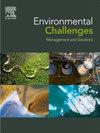Decoding dynamic landslide hazard processes for a massive refugee camp in Bangladesh
Q2 Environmental Science
引用次数: 0
Abstract
Landslides disrupt human ecology worldwide, making practical hazard assessments essential for saving lives and assets. Dynamic assessments, which capture temporal changes in susceptibility, remain rare due to limited multi-temporal landslide inventories. This study addresses this gap by implementing a slope unit (SU)-based dynamic landslide hazard assessment for the Kutupalong Rohingya Refugee Camp (KTP), a region undergoing rapid environmental and landscape changes due to a massive human influx. Here, we decode dynamic landslide hazard processes by employing a Generalized Additive Model (GAM), a flexible statistical method, to explore how landslides (dependent variables) are linked to independent variables like continuous factors (e.g., slope, soil depth, rainfall) and categorical factors (e.g., soil type, landcover change category). We produced multi-temporal inventories to represent conditions before (2018 and prior) and after (2021 and prior) the establishment of refugee settlements. Anthropogenic modifications, such as distance from roads, land-use/NDVI changes, and rainfall, are treated as dynamic factors, while other factors are considered static predisposing conditions. Our GAM approach performs better than standard machine learning (ML) techniques (e.g., Random Forest, Support Vector Machine, Neural Networks), achieving an overall ROC-AUC of 0.84 and a mean cross-validated AUC of 0.81, compared to AUC (0.64-0.74) for ML models. We also performed uncertainty quantification and repeated random simulations (Monte Carlo simulations) to identify slope units with increased, decreased, or unchanged susceptibility. Priority SUs requiring immediate risk reduction measures are flagged, offering actionable insights for local authorities. Our research findings advance landslide hazard assessments by integrating time-varying dynamic processes with a slope units-based approach and facilitating risk mitigation at KTP.
解码动态滑坡灾害过程在孟加拉国的一个大规模难民营
山体滑坡破坏了世界范围内的人类生态,使实际的灾害评估对拯救生命和财产至关重要。由于多时间滑坡库存有限,捕捉易感性时间变化的动态评估仍然很少。本研究通过对库图帕隆罗兴亚难民营(KTP)实施基于斜坡单元(SU)的动态滑坡危害评估来解决这一差距,该地区由于大量人口涌入而经历了快速的环境和景观变化。在这里,我们通过采用广义可加模型(GAM)这一灵活的统计方法来解读动态滑坡危害过程,以探索滑坡(因变量)如何与连续因素(如坡度、土壤深度、降雨)和分类因素(如土壤类型、土地覆盖变化类别)等自变量相关联。我们制作了多时间清单来代表难民定居点建立之前(2018年及之前)和之后(2021年及之前)的情况。人为变化,如与道路的距离、土地利用/NDVI变化和降雨,被视为动态因素,而其他因素被视为静态诱发条件。我们的GAM方法比标准机器学习(ML)技术(例如,随机森林,支持向量机,神经网络)表现更好,与ML模型的AUC(0.64-0.74)相比,总体ROC-AUC为0.84,平均交叉验证AUC为0.81。我们还进行了不确定性量化和重复随机模拟(蒙特卡罗模拟),以识别敏感性增加、减少或不变的斜坡单元。需要立即采取风险降低措施的优先SUs被标记出来,为地方当局提供可操作的见解。我们的研究成果通过将时变动态过程与基于边坡单元的方法相结合,推进了滑坡危害评估,并促进了KTP的风险缓解。
本文章由计算机程序翻译,如有差异,请以英文原文为准。
求助全文
约1分钟内获得全文
求助全文
来源期刊

Environmental Challenges
Environmental Science-Environmental Engineering
CiteScore
8.00
自引率
0.00%
发文量
249
审稿时长
8 weeks
 求助内容:
求助内容: 应助结果提醒方式:
应助结果提醒方式:


